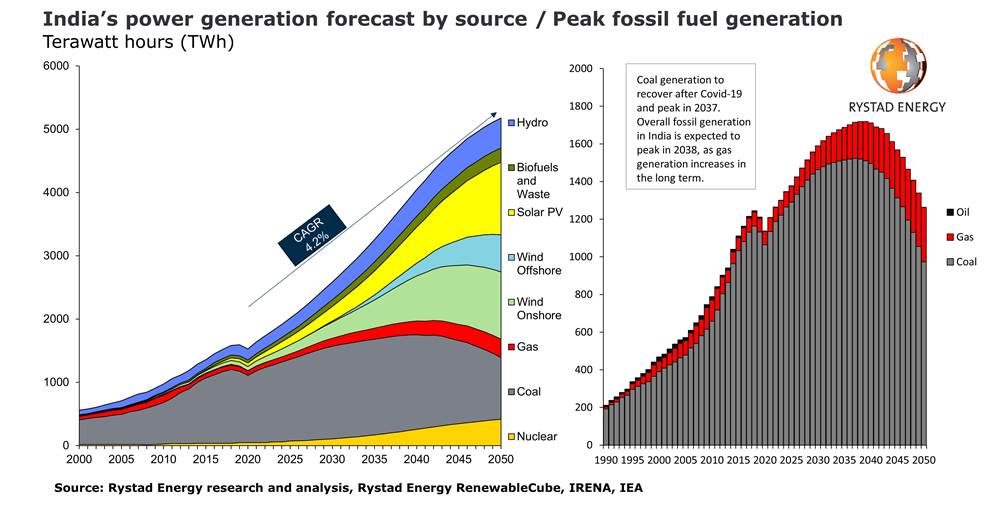Indian power generation from coal fell to a five-year low of “just” 1,064 terawatt-hours (TWh) in 2020 due to the Covid-19-induced slowdown. This was only a dip, however, as coal still makes up a gigantic 70% of the country’s total electricity production and is set to come back with a vengeance, growing by 43% to 1,523 TWh in 2037, when Rystad Energy expects coal power to finally peak.
As surprising as the projection may be to some, such a surge in coal consumption is not that unexpected. India’s power generation is set to grow exponentially to 3,565 TWh by 2037, more than double 2020’s figure. Electricity production will already exceed 2,000 TWh from 2025 and is set to breach the 3,000 TWh ceiling from 2034 as a result of an electrification boost and economic growth.
In fact, Rystad Energy expects India’s electricity generation to increase with an average annual growth of 4.2%, effectively tripling its current level over the next 30 years.
The outlook is not all grim for clean electricity, though. Today’s power mix will be unrecognizable in three decades as the government pushes for greener initiatives. Rystad Energy forecasts all renewable sources grouped together (wind, solar, hydro, and biofuels/waste) will surpass fossil fuels in India’s total power generation by 2038. Further out, we expect solar to outcompete coal by 2050 in terms of the largest share in the power mix.

“India has made some progress in meeting sustainable development goals and its government has set ambitious targets. However, even though it has huge potential for clean power generation, our view is that in the short term its renewable targets are too ambitious. It may take a bit longer, but eventually we will see renewable power dominate,“ says Fabian Rønningen, gas and power analyst at Rystad Energy.
New solar and wind projects are projected to accelerate the growth of India’s renewable power generation. Rystad Energy expects electricity produced by solar PV to grow to 65 TWh in 2021 from 55 TWh in 2020, and then rise further to 128 TWh through 2025 and 233 TWh in 2030.
Power generated by onshore wind turbines, from 69 TWh in 2020, is set to rise to 82 TWh in 2021 and 143 TWh in 2025. In 2030, produced electricity from this source is expected at 254 TWh.
Solar power production will continue to grow even more after 2030, but as onshore wind is also set for a massive boost, solar will only overtake onshore wind towards the end of 2050, Rystad Energy projects.
The only fossil fuel to see an uninterrupted rise in use towards 2050 is gas, even though its share will never become a significant one for India. Rystad Energy expects gas-generated electricity to rise to 73 TWh in 2021 from 71 TWh in 2020, and then reach 85 TWh in 2025 and 128 TWh in 2030 – by which time it will make up about 5% of the total power mix.
Many countries around the world are relying on gas to transition away from coal and into renewables. However, given the limited access to gas supplies and the country’s economic dependence on the coal industry, India is expected to continue to use coal power to provide stability for the exponential growth in renewable power generation.
India’s installed capacity
With tens of gigawatts of coal plants still under construction and in the planning phase, capacity from this source – which in the end of 2020 stood at 228 TW – is expected to continue to increase and reach a peak of 265 GW by 2027. After this, we forecast coal capacity to remain relatively stable and then drop sharply in the 2040s as renewables continue to grow exponentially and the government puts more focus on reducing carbon emissions.
However, given that coal power generation is such a big part of the total capacity and that the government has not put in place a plan to decommission coal plants, we expect that close to 200 GW of India’s coal power generation will remain active by 2050.
Solar PV capacity is forecast to overtake coal by 2036 and could reach almost 650 GW by 2050. We expect a boom in solar PV development in India due to the country’s excellent solar conditions, the strength of solar PV as a distributed energy source, as well as the continued cost decline of utility-scale solar PV in India. Wind (onshore and offshore) is expected to follow a similar path, reaching 575 GW of installed capacity by 2050.
To support this massive integration of renewable intermittent energy sources, we expect a strong increase in energy storage in the long term, totaling 31 GW by 2030, 93 GW by 2040 and 224 GW by 2050. However, coal could continue to provide baseload and stability to the system in the long term.
In the short term, we see that storage capacity remains dominated by pumped hydro, by far the most widespread technology today. In the future, we also expect significant growth within the battery energy storage segment in India, with most of the growth coming after 2035. We believe this technology currently is the best option for short-term balancing between demand and supply, as well as an excellent source for frequency control and overall grid support in renewable energy-dominated systems.

Follow us on social media: